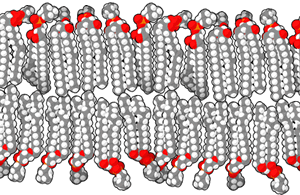M. D. Whitmore

B. Sc., M. Sc., Ph. D. McMaster University
Professor, University of Manitoba
Research Interests
Systems containing macromolecules, in which at least one type of component consists of two or more distinct chemical species, can exhibit fascinating, and sometimes quite subtle, phase behaviour. Two distinct classes of macromolecules are under study. One consists of relatively high molecular weight block copolymers which can form equilibrium, periodic microdomain structures of various symmetries. The sizes of the domains are on the order of tens or hundreds of angstroms, and the material within each one is usually amorphous. In the presence of surfaces, these molecules can also form polymer brushes. The second class of molecules consists of phospholipids, each of which is composed of a polar headgroup bonded to one or two hydrocarbon chains. The overall goal of this research is the development of statistical mechanical theories which can make quantitative predictions and which illustrate the controlling factors and underlying physics.
Polymers
Our work in polymers is focused primarily on block copolymers and end-tethered polymers. Block copolymers are composed of two or more distinct sections, or "blocks", of different chemical species, e.g., polystyrene and polyisoprene. In the absence of the chemical bonds between the blocks, these species would separate into different domains, typically microns in size. This is not possible for copolymers, because of the intramolecular bonds. Instead, the systems self-assemble into a variety of microphase structures, with the equilibrium structure determined by temperature, composition, and total molecular weight. The domains form ordered arrays, but the material within each domain is disordered. Our recent work was aimed at understanding this phase behaviour, and probing the details of each structure. A related system, called the polymer brush, forms when one of the copolymer blocks adsorbs tightly onto a surface with the second block "dangling" into a host solvent, or when a homopolymer is end-anchored to the surface. Our current focus is on polymers grafted to the inner surfaces of microtubes, and their effect on flow within the tube.
Phospholipid Bilayers
A major constituent of cell membranes is a chemical class known as phospholipids. These molecules are amphiphilic in that they are usually composed of a hydrophilic phosphate headgroup and, usually, two hydrocarbon chains. When immersed in water, they self-assemble into bilayers, with the headgroups in contact with the solvent and the chains forming the bilayer interior; these structures can exhibit unique phase behaviour and morphologies.

The main phases include the relatively disordered liquid crystal phase, the relatively ordered gel phase, and the relatively ordered interdigitated gel phase. Transitions are driven by such things as temperature, composition, and pressure. The goal of this research is to understand and predict equilibrium behaviour and structures.
Bio and Soft Matter Physics at The University of Manitoba
Teaching Interests
I have taught courses at all levels, from introductory calculus- and algebra-based first year, to senior graduate level. My particular interests are in mathematical physics and condensed matter physics.I have been a member of teams that developed the Microcomputer Physics Laboratory and the first course taught there, Computational Physics and Data Analysis, and Memorial's interdisciplinary M.Sc. degree in Computational Science, and Ph.D. in Condensed Matter Physics. I have also helped develop a number of new undergraduate and graduate courses, and initiated and chaired a large-scale revision of the undergraduate program.
Career History
I have been involved in a number of national and regional projects. I was active in the national computing organization C3.ca, serving for a number of years as a member of the Executive Committee, Board of Directors, and chair of the Technical Analyst Support Personnel Review Committee. I was the principal investigator on the multi-university NSERC MFA grant called HPCnet which supported access to high performance computers. Within Memorial, and in partnership with five other organizations, I was the PI on a CFI grant for the Memorial University Advanced Computation and Visualization Centre, and a participant a multi-disciplinary M.Sc program in Computational Science, the first of its kind in Canada. I led a 7-university proposal to create a new Atlantic Canada consortium called the Atlantic Computational Excellence Network, or ACEnet, with the combined goals of acquiring shared computing resources throughout the region, drawing together researchers with common interests into regional research communities, attracting new researchers to the region, and securing additional financial support for their research. I was also a founding member of Genome Atlantic, a not-for-profit corporation founded in 2000 with the objective of establishing international leadership in selected areas of genomics research, and to build genomics investment and economic growth in Atlantic Canada. I have served on the boards of Genome Atlantic, ACEnet, CANARIE, Smartpark, Birds Studies Canada and The University of Manitoba, was Dean of Science from 2004-14 and currently sit on the boards of TRIUMF and the Verna Kirkness Foundation.
M. D. Whitmore211 Allen
University of Manitoba
Winnipeg, MB
R3T 2N2
Canada
Phone: (204) 474-6204